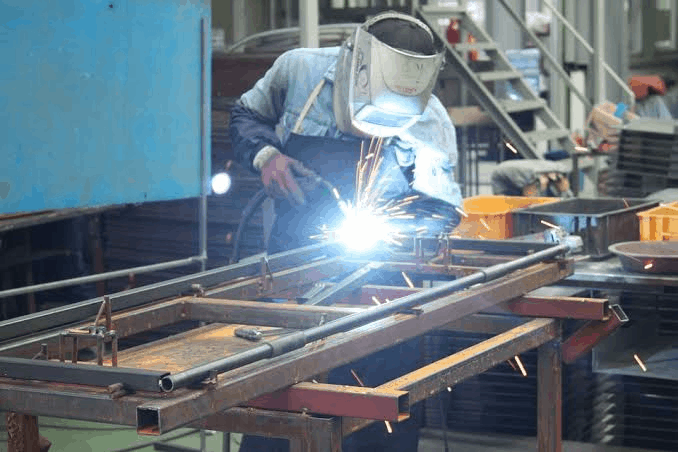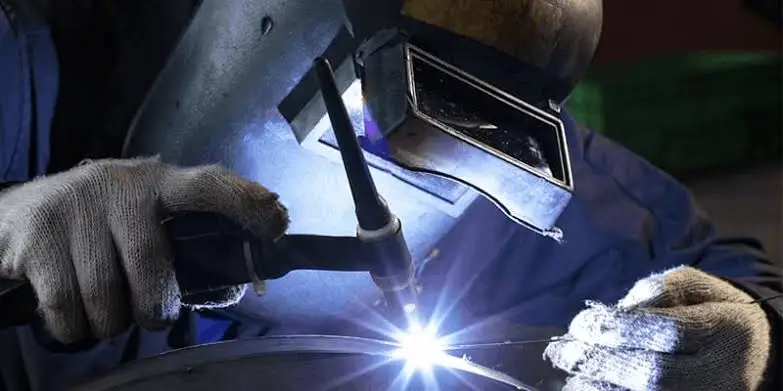Having a welding helmet is vital if you are going to avoid destruction to your eyes during welding. There many sparks that fly around and the ultraviolent light of the welding process can cause harm to your eyes. It is not true that the most expensive or cheapest is more ideal than the other. If you have the wrong helmet then you are going to experience serious injuries to your head and body. If a helmet is too heavy then it is going to hurt your neck hence causing you constant fatigue.
The ideal helmet should have the right shading options. Sensor option filter out flashes and this helps in protecting your eyesight. The nature of your welding jobs will also influence the kind of helmet that you use. A helmet should be lightweight so that it gives you the flexibility to move around. Most of the welding helmets around measure a decent 20 oz.
Speedgas 9100xx– Overview
The 3M speedgas 9100xx comes in six welding models. The models will come with a variety of options for safety and respiratory. The Speedgas 9100xx is a comfy headgear with a closed and open side windows for better vision. However, you should keep it closed when welding so that you do not have any sparks going through the headgear. The view is excellent for grinding, cutting, and just having a good look of your workshop.
The speedgas comes with a viewing area of 4.2” X 2.8”, 3 arc sensors, and optical class of 1/1/1/2. The shade range is 5, 8-13 and weight of 595 grams. 3M speedgas is one of the most professional and classy welding helmets around. It is comfortable and with an amazing visibility of surrounding areas. It is comfortable meaning you can wear it for long without problems to your head and face. When it comes to weight the speedgas is lightweight which makes it ideal for long welds without you suffering head or neck pains. It is padded near the headband and you get two adjustable head straps to hold the headgear in place during welding.
The manufacturers have really worked out on the speedgas design to ensure maximum visibility. You can use the speedgas for MIG or TIG welding. To help reduce heat buildup within the head gear you have air vents. Two replaceable lithium batteries power the speedgas.
Speedgas problems
The speedgas 9100xx has many positives but this has not been without complaints. Some consumers have complained that the headgear is a bit bulky while some have had problems with the shades. The breathing ports are known to let in smoke making the speedgas not ideal for some welding techniques. The major problem with the speedgas 9100xx from consumers is they find it a bit overprized. Considering it goes for more than $627 you would expect more from it. However, you will hear users complain about faulty cover lenses and the solar not working. Some welders have a preference for the older 9002 version as they claim the lens was better.
The open Speedgas windows are known to cause some weld burns so you need to pay attention to them whenever welding.
Factors to consider for a welding helmet

Helmets fall in various categories. You have fixed or variable shade, passive or auto-darkening, three or four sensors, and the viewing size varies. It is imperative that you put into consideration this factors when you are choosing a welding helmet.
Helmet weight
It is vital that you select a helmet that is lightweight; this prevents putting pressure on your neck hence causing fatigue during welding. This is particularly important if you are going to be working in a fabrication shop the whole day. An ideal helmet will have an average weight of around 20 oz. However, the cheaper the helmet the heavier it is. If you are doing welding for your side projects then weight should not be such a big factor, just have something that protects your eyes.
Helmet sensors
If you have gone to the market to purchase a helmet you have probably encountered sensor classification for the helmet. You have two, three or four sensor helmets. The work of the sensors is they capture any flashes as you move the helmet in different angles. Most of the cheap helmets come with two sensors while the pricier ones come with four sensors. Four sensor helmets are capable of capturing flashes from all directions. This makes them ideal for pipe welding.
Lens shade options
Good helmets come with various lens shade options. This offers you great flexibility in number of welding options. You can use it for cutting or grinding metal. At the bottom of the pyramid we have shade option 9-13. This is the most standard and is enough to do most of the welding work available.
You also have fixed and variable darkening options. Auto-darkening is a feature you will find in both hobbyist and professional welding helmets. With a fixed shade darkening feature the helmet will detect an electric arc. This type of helmets have a fixed #10 and combine both benefits of auto-darkening and fixed shade. For most welding applications you will discover that the welding technique is almost similar meaning having any fixed shade helmet will do the trick. This kind of applications tend to use similar metals and amperage. However, if you plan on using varying welding techniques like TIG, MIG and stick welding then you will profit from a variable shade helmet. This allows you to adjust the helmet depending on the arc brightness and amperage usage. You can adjust the variable helmets from 9 to 13.
Helmet power source

When selecting a helmet it is vital that you carefully examine the power supply. Some of the helmets have fixed power supply that you cannot replace. Find one with replaceable power source or one that is solar powered. Some helmets will use batteries and solar. This means the solar power source works with the batteries to extend power supply. This is ideal for those who weld outside. For the best helmet find one with an auto-setting feature. This allows you to conserve power when you are not welding.
Viewing area size
The viewing area should be at the top factor whenever you are in search for the best helmet. A larger viewing area puts less strain on your neck as you do not have to move your head around for better visibility. If you are working on a large piece of metal then a large viewing area will come in handy. Most of the top helmets have a viewing area of about 3.74 X 3.34 inches.
Proper fitting helmet
Comfort should be a consideration whenever you are in search of the right helmet. Having padded sides helps relieve pressure on your neck and head during long welding. The ideal helmet should not leave your skin exposed during welding. This helps protect you from UV rays and spatter. If you are working on a metal like aluminum then the chances of experiencing burns is high. To offer you more protection, most of the welders will add a welding bib to their helmets.
Passive vs. auto darkening lenses
The American Welding Society is responsible for the various classifications of shading numbers. The shading is vital for protecting your eyes against all forms of UV rays and harmful infrared. For low welding applications all you need is 8 shade while for high welding applications is 13. If you are going to be doing some cutting or grinding then go for one that offers you ranges 3 and 8. The passive lens helmet uses IR coated dark tinted and UV tinted glass. The shade classification is 10. The problem with passive lenses is that you have to wear it in an upward position as you work on your torch. When working you will need to snap the helmet into position as you work on your arc.
The downside of using the passive helmet is that it posses challenges when you are a novice as you have to know how to position the helmet with the electrode. Before you get used to it, you may experience various poor weld starts. The auto-darkening helmet addresses some of the shortcomings of the passive helmet as it comes with shade 3 and 4. This makes it a very easy to use helmet. The best part is that whenever the helmet detects an arc it automatically darkens in a second. It will immediately darken to shade 8 or 13. The auto-darkening helmet will remain in position no matter the position of an electrode. You no longer need to snap the helmet to place like the passive helmets.
Conclusion
The SM speedgas 9100xx is one of the best welding helmets in the market. It offers great visibility and allows you to do cutting and grinding. The helmet lightweight making it ideal for moving around in fabrication workshops. It is comfortable and you will not experience much neck pains. The downside is the helmet is pretty expensive and does not come with solar power. This is a serious setback as most helmets in its price range have one.
